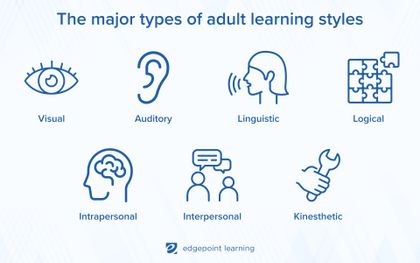7 Adult Learning Styles And Best Practices To Follow
Corey Bleich
🍿 5 min. read
You already know that your company is made up of unique individuals, and you work hard to address that diversity in your training. Add another layer by incorporating the following seven adult learning styles (and best practices for each).
How adults learn: Major differences
Knowing how adults learn is crucial when designing your employee training. It seems like common sense, but it’s important to be clear: You cannot design and present material for adults in the same way you would for children and expect good results.
What are the major differences between child and adult learners?
- Whereas children often require help, adults crave autonomy
- Children have a narrower viewpoint, but adults bring life experience to their learning
- Casting a broad net with kids is fine, but adults want direct application
- Kids might do it because you say so, but adults require more motivation
Within these differences, adult learning styles further complicate how adults learn. Learners of all ages are wired differently.

Adding the specialized requirements of adult learners to different learning styles is a big lift, but then consider the cognitive impact of a training. All learners can only handle so much information before they are unable to process and apply it.
Training that makes sure your material is presented in the proper way with a consideration of learning styles helps lighten that cognitive load. Put simply, and when done well, employees don’t have to work so hard just to understand the material.
The major types of adult learning styles
Research has shown that not everyone learns the same way. Consider the following adult learning styles as you design your employee training programs.
1. Visual/spatial
Visual/spatial learners lean heavily on images to process new information. These learners are able to vividly picture patterns and learn best with images and graphics that use fewer words.
Further, these learners can literally see the forest and the trees. They are good at making connections in visual/spatial relationships and may be able to see details that others miss.
How to design training for this type of learner
Consider infographics, drawn guides, and text broken up with illustrations. Or, use PowerPoints, flipcharts, videos, and graphics to better reach this type of learner.
2. Auditory
Auditory learners learn by hearing information, retaining up to 75% of it. While only 30% of people are auditory learners, the majority of training already focuses on this adult learning style.
That's because auditory learners are one of the two types of adult learning styles that are easiest to design training for (the other is linguistic learners). Schools are designed around this type of learner.
How to design training for this type of learner
Lectures, podcasts, and traditional classroom-style learning is geared towards auditory learners. The best adult learning methods for auditory learners incorporate these resources into training.
3. Linguistic learners
Linguistic learners process information best through speaking and language. They are often voracious readers and able to pick up other languages (and nuances in their own language).
Consider a book group that reads a book and then uses guided questions to unpack themes and deepen understanding. Linguistic learners function the same way.
Further, a linguistic learner is generally a good communicator. They might listen to someone speaking and then summarize what was said to gain clarity or identify anything they missed.
How to design training for this type of learner
Linguistic learners will pick up anything you write down. Communication via discussion boards is a great way to reach them if you have online training.
Adult learning techniques for linguistic learners also use small-group discussion, guided readings, and writing exercises. Simply including closed captioning is a big benefit for this type of learner.

4. Logical/mathematical learning
Logical/mathematical learners use distinct processes to break down learning into steps. Think about how the scientific method is applied, and you have a great example of how this learning style works.
These adult learners are great at analyzing problems logically and developing solutions for them. And, if you are worried that your training is not in the proper sequence or doesn’t follow a logical flow, this learner will let you know!
How to design training for this type of learner
Troubleshooting and analyzing are two places where this learner does well. Gamification using simulations is also a great way to reach this learner.
Further, use bullet points, logical steps, and flow charts to help this type of learner understand new concepts.
5. Intrapersonal
Intrapersonal learners require solitude and reflection to really take new information on board. These quiet thinkers need time and space to reflect on and integrate new material. This allows for deeper insights and helps transfer old information to new settings.
Intrapersonal learners also are excellent at generating new ideas and making connections that may not be obvious on the surface.
How to design training for this type of learner
Incorporating time for reflection into training is especially important for this type of learner. Also allowing for longer response times will help intrapersonal learners to participate more in discussions.
Incident reports and program evaluations are two activities where intrapersonal learners shine. Any learning activity that requires a step back and a pause for thought suits this adult learning style.
6. Interpersonal
Social interaction is key for this type of adult learner. Interpersonal interactions help these learners process information. Through social cues, conversation, and discussion, they integrate their learning into memory.
Interpersonal learners are often extroverts who are ready and willing to guide discussions with good emotional intelligence. They are good at reading social cues and can help interpret a group’s response to a training activity.
How to design training for this type of learner
Small-group, in-person discussions that lead to large-group conversations suit this learner who thrives in social situations.
Provide formal and informal opportunities to interact with information in groups.
7. Kinesthetic
Kinesthetic adult learners process information by doing. It’s not enough to tell them how something works – this type of adult learner needs to put their hands on to experience it. This is one of those learning styles that needs action to make information stick.
How to design training for this type of learner
On-the-job, experiential trainings are best for this type of learner. When possible, pair kinesthetic learners with a mentor who can provide hands-on training. Another option is AR or VR training that allows learners to work through simulations of key activities.
This learning style will not benefit as much from videos or written training.
Build better training for your employees
Differentiating training for all of your adult learning styles is complex. EdgePoint Learning offers everything from consulting on training you’ve already developed to designing a full training program from the ground up.
Get in touch today to see how we can help!
